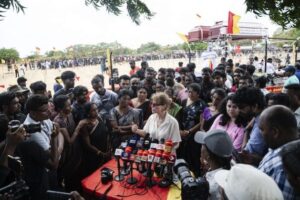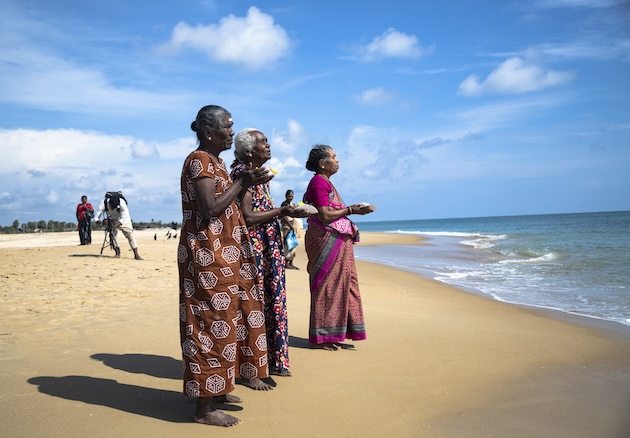
Asia-Pacific, Civil Society, Climate Action, Climate Change, Climate Change Justice, COP29, Energy, Environment, Featured, Global, Headlines, Indigenous Rights, Peace, TerraViva United Nations
–
CIVICUS discusses the recent Pacific Islands Forum (PIF) meeting in Tonga with Jacynta Fa’amau, Pacific Campaigner at 350.org, a global civil society organisation campaigning for climate action.
Representatives from 18 countries gathered in Tonga for the 53rd Pacific Islands Forum Leaders Meeting from 26 to 30 August, seeking to address issues including the climate crisis, socio-economic challenges and political conflict in New Caledonia. A key agenda item was securing funding for the Pacific Resilience Facility, a climate finance mechanism aimed at supporting communities affected by climate change. Civil society called on Australia, the world’s third largest fossil fuel exporter and a co-founder of the Forum, to demonstrate real climate leadership by phasing out fossil fuels and transitioning to renewable energy.

Jacynta Fa’amau
What was on the agenda at the recent PIF Leaders Meeting?
The PIF is an intergovernmental body that aims to improve cooperation between Pacific states and territories, Australia and New Zealand. We may be divided by national borders, but we are united by the ocean, and many of the issues that affect one island can provide valuable lessons for another. As a Samoan, I know my future is linked to that of a sister in the Solomon Islands or a brother in the atolls of Kiribati.
PIF meetings bring together regional leaders to discuss the most pressing issues facing our region. At the 53rd session, the agenda focused on several issues, including climate change, climate finance, education, health and the Pacific Policing Initiative – an Australia-backed strategy to train and support police.
But climate issues were at the top of the agenda. As Pacific Islanders, we know that phasing out fossil fuels is critical to our survival. We deserve not just resilience, but the ability to thrive in the face of this crisis. To do this, we need access to adequate climate finance and affordable renewable energy. The Pacific Resilience Facility is part of the way to achieve this, with an emphasis on ensuring accessibility for communities. Leaders had already endorsed Tonga as the host country for this financial facility, so now the key priority is to secure the resources.
What were civil society’s priorities, and what did it bring to the table?
Civil society has a vital role to play in holding leaders to their promises and creating pathways for communities to get involved. The PIF’s Civil Society Village hosted remarkable groups such as the Pacific Islands Climate Action Network and the Pacific Network on Globalisation, which are working to bridge the gap between civil society and policymakers.
As for 350.org Pacific, our role has always been to ensure that communities have the tools they need to take part in multilateral discussions that often seem far removed from realities on the ground. There’s no point in making decisions about the people you serve if you do it without their input. Before the PIF began, we held the Our Pawa Training with over 200 young people and students across Tonga. ‘Pawa’ references the people power driving the climate movement and the promise of a Pacific built on safe, ethical renewable energy. This training equipped young Tongans with tools to engage in climate conversations.
Our top priority is to ensure a safe and liveable future for the Pacific. Scientists have made it abundantly clear that our survival depends on an immediate global phase out of fossil fuels. Wealthier nations must phase out first, and historical emitters must support the global south in achieving their phase out.
The Pacific mustn’t be left behind in the renewable energy revolution. It’s unfair that our islands should bear the financial burden of recovering from a crisis we didn’t cause. We need the resources and expertise to transform our energy systems on our own terms and put the land, sea and wellbeing of Pacific Islanders first. We call for accessible climate funding to meet the Pacific Resilience Facility’s US$500 million target.
For us, this means Australia must turn its climate rhetoric into action.
Why is Australia at the centre of civil society’s demands?
As the region’s biggest producer of fossil fuels and the third largest exporter in the world, Australia plays a significant role in the climate crisis that threatens our survival. To come to the lands of our ancestors and claim climate leadership while signing our death warrants with every gas project you approve is immoral and unacceptable.
But we also hold Australia to high standards because it claims to be our family. In the Pacific, kinship puts the welfare of the many before the greed of the one. There’s no world in which Australia can be a true partner to the Pacific while continuing to exploit fossil fuels. With every tonne of coal exported, Australia is exporting climate disaster to our islands.
Australia must commit to phasing out fossil fuels, domestically and in its exports. It must ensure the Pacific is not left behind in the transition to renewable energy and commit to the funding it’s historically owed to the victims of the climate crisis. The Ki Mua Report commissioned by the Fossil Fuel Non-Proliferation Treaty Initiative found that eight Pacific countries could transform their energy systems for less than a seventh of the amount Australia gives to the fossil fuel industry.
With its potential COP31 presidency on the horizon, Australia has the chance to become the climate leader it claims to be.
Did the outcomes of the PIF meeting meet your expectations?
We had high expectations, particularly on climate action, given the recent report by the World Meteorological Organisation on the accelerated sea level rise our region faces. The Pacific is particularly vulnerable, so we need to be exceptionally ambitious. Despite our negligible contribution to this climate crisis, we have set ourselves ambitious climate targets. We have been innovative in our adaptation strategies and ambitious in our climate finance goals.
And while the PIF’s final communiqué is an encouraging step towards securing the resources we need to tackle the climate crisis, there’s a disappointing lack of pressure on the region’s major fossil fuel producers to commit to a phase out.
The PIF’s focus on peace and stability was important given the current sovereignty struggles and the shadow of a geopolitical tug-of-war hanging over our islands. But the climate crisis remains the most pressing security threat we face. With each new cyclone comes increased instability, and with each displaced community comes a host of security issues.
The time for deliberation is long past and the time for action is upon us. The PIF may be over, but the journey to COP29 is just beginning. We Pacific climate warriors will continue to celebrate our culture and ancestors as we advocate for decisive climate action that will help us achieve a safe and sustainable future for the Pacific. We hope those with the power to effect change will choose to join us.
Get in touch with 350.org through its website or Facebook and Instagram pages, and follow @350 on Twitter.


















